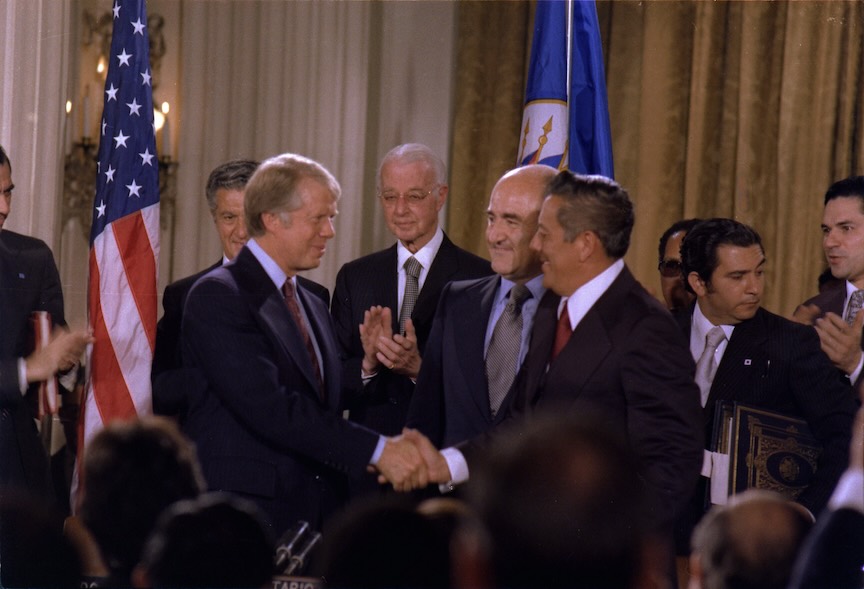
The continued American control of the Panama Canal sparked protests in Panama and across South America. President Carter supported a treaty to return control to Panama, leading to the 1977 Torrijos-Carter Treaties. These agreements ensured Panama would regain full control by 2000, while the U.S. retained the right to defend the Canal. Despite strong Senate opposition, the treaty was narrowly approved..
The Panama Canal, a vital strategic and economic waterway connecting the Atlantic and Pacific Oceans, had long been under American control since its completion in 1914. However, by the mid-20th century, the continued U.S. ownership of the Canal became a source of growing resentment in Panama, reflecting a broader sense of nationalism and a desire for sovereignty over its territory. This sentiment was not isolated to Panama but resonated across South America, where the Canal was seen as a symbol of American imperialism and interference in regional affairs.
In the United States, the idea of relinquishing control over the Canal was met with significant resistance. The Canal was regarded as a crucial asset for both commercial and military purposes, especially during the Cold War, when control of global shipping routes was of paramount importance. However, by the 1970s, it became increasingly clear that continued American ownership would lead to escalating tensions and potential conflict in the region.
President Jimmy Carter, who took office in 1977, recognized the need to address this growing discontent. He believed that reaching a new treaty with Panama would not only prevent violence but also improve U.S. relations with Latin America. Carter was also committed to principles of fairness and self-determination, making him more inclined to negotiate a return of the Canal to Panamanian control.
On September 7, 1977, the United States and Panama, under the leadership of General Omar Torrijos, reached a historic agreement known as the Torrijos-Carter Treaties. The accord was comprised of two separate treaties. The first, the Panama Canal Treaty, stipulated that Panama would gain full control of the Canal by December 31, 1999. This was a monumental decision, as it marked the end of over six decades of American control. The second treaty, the Neutrality Treaty, guaranteed that the Canal would remain neutral and open to ships of all nations even after Panama assumed control. Additionally, it allowed the United States to maintain the right to defend the Canal if necessary, ensuring that the U.S. could protect its interests in the event of any threat to the Canal's security.
Despite the significant diplomatic achievement, the treaties faced intense opposition in the United States, particularly in the Senate. Many Senators, as well as a large portion of the American public, were deeply concerned about the potential loss of such a strategically important asset. They feared that transferring control to Panama could jeopardize the security and operation of the Canal, which was vital to both global commerce and U.S. military strategy. Opponents of the treaty argued that Panama, a smaller and less stable nation, might not be capable of managing the Canal effectively.
The ratification of the treaties required a two-thirds majority in the Senate, and the debate was fierce. President Carter engaged in a rigorous campaign to secure the necessary votes, emphasizing the importance of honoring international commitments and improving relations with Latin America. He also highlighted the strategic benefits of maintaining the right to defend the Canal, which would still allow the United States to protect its interests.
In the end, the treaties were ratified by a narrow margin, passing with just one vote more than the required two-thirds majority. This victory was a testament to Carter's political skill and his administration's commitment to diplomacy and international cooperation. The approval of the treaties marked a turning point in U.S.-Latin American relations, signaling a shift away from the era of American dominance and towards a more equal partnership with its neighbors.
The transfer of the Panama Canal to Panamanian control was completed as scheduled on December 31, 1999. While there were initial concerns about the transition, Panama has successfully managed the Canal, which continues to be a crucial artery for global trade. The Torrijos-Carter Treaties are now seen as a significant milestone in the history of U.S. foreign policy, representing a commitment to fairness, diplomacy, and the peaceful resolution of disputes.
 >
>